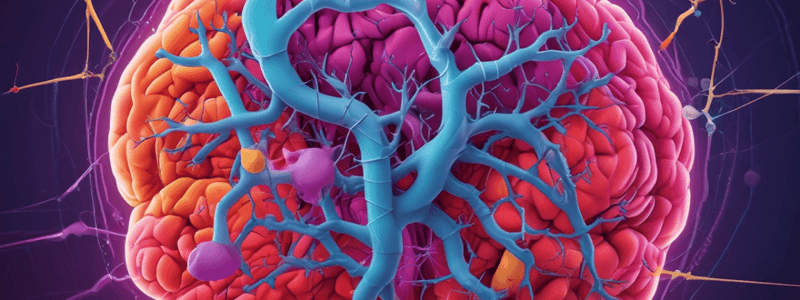Podcast
Questions and Answers
What is one of the neural mechanisms proposed to contribute to symptom reductions from ketamine administration?
What is one of the neural mechanisms proposed to contribute to symptom reductions from ketamine administration?
- Modulation of glutamate transmission (correct)
- Activation of acetylcholine receptors
- Enhancement of dopamine modulation
- Inhibition of serotonin synthesis
Which downstream signalling cascade is activated in animal models following acute ketamine administration?
Which downstream signalling cascade is activated in animal models following acute ketamine administration?
- Protein kinase A (PKA)
- Mammalian target of rapamycin (mTOR) (correct)
- AMP-activated protein kinase (AMPK)
- Janus kinase (JAK)
What does the prevailing hypothesis suggest about the impact of ketamine on NMDA receptor-mediated glutamatergic input?
What does the prevailing hypothesis suggest about the impact of ketamine on NMDA receptor-mediated glutamatergic input?
- It triggers GABA-ergic neurotransmission
- It suppresses synaptic excitation (correct)
- It increases acetylcholine activity
- It enhances overall inhibition
Which factor contributes to the rapid and robust effectiveness of ketamine in chronic mental health conditions?
Which factor contributes to the rapid and robust effectiveness of ketamine in chronic mental health conditions?
Why are symptom reductions from ketamine administration often considered transient?
Why are symptom reductions from ketamine administration often considered transient?
What role does ketamine play at a microscopic scale in chronic pain conditions?
What role does ketamine play at a microscopic scale in chronic pain conditions?
What is the main challenge in assessing the efficacy of Ketamine Assisted Psychotherapy (KAP) according to the text?
What is the main challenge in assessing the efficacy of Ketamine Assisted Psychotherapy (KAP) according to the text?
What is the potential benefit of using Ketamine Assisted Psychotherapy (KAP) according to the text?
What is the potential benefit of using Ketamine Assisted Psychotherapy (KAP) according to the text?
What is the purpose of continued engagement in psychotherapy after ketamine administration according to the text?
What is the purpose of continued engagement in psychotherapy after ketamine administration according to the text?
What is one factor that makes generalizing the findings of the studies on Ketamine Assisted Psychotherapy (KAP) difficult?
What is one factor that makes generalizing the findings of the studies on Ketamine Assisted Psychotherapy (KAP) difficult?
What is the potential unmet clinical need that the use of Ketamine Assisted Psychotherapy (KAP) can fulfill according to the text?
What is the potential unmet clinical need that the use of Ketamine Assisted Psychotherapy (KAP) can fulfill according to the text?
What is the role of ketamine in the context of Ketamine Assisted Psychotherapy (KAP) according to the text?
What is the role of ketamine in the context of Ketamine Assisted Psychotherapy (KAP) according to the text?
How many patients reported an increase in pain intensity after receiving ketamine treatment?
How many patients reported an increase in pain intensity after receiving ketamine treatment?
What was the maximum ketamine dosage used for the patient with Complex Regional Pain Syndrome (CRPS)?
What was the maximum ketamine dosage used for the patient with Complex Regional Pain Syndrome (CRPS)?
What additional therapy was provided along with ketamine infusion for the patient with CRPS?
What additional therapy was provided along with ketamine infusion for the patient with CRPS?
What was the reported pain level (NPRS score) of the CRPS patient at 1-year follow-up after the initial ketamine infusion?
What was the reported pain level (NPRS score) of the CRPS patient at 1-year follow-up after the initial ketamine infusion?
In the study by Dakwar et al., what was the control intervention used for comparison with ketamine?
In the study by Dakwar et al., what was the control intervention used for comparison with ketamine?
Based on the information provided, what can be inferred about the potential benefits of ketamine treatment for chronic pain?
Based on the information provided, what can be inferred about the potential benefits of ketamine treatment for chronic pain?
According to studies, which of the following factors may contribute to non-response to ketamine treatment in some individuals?
According to studies, which of the following factors may contribute to non-response to ketamine treatment in some individuals?
In clinical trials investigating ketamine for treatment-resistant depression, what is a common reason for participant dropout?
In clinical trials investigating ketamine for treatment-resistant depression, what is a common reason for participant dropout?
Which of the following comorbid factors may influence the effectiveness of ketamine in managing chronic pain?
Which of the following comorbid factors may influence the effectiveness of ketamine in managing chronic pain?
In tailoring ketamine dosage for optimal therapeutic response, which of the following factors should be considered?
In tailoring ketamine dosage for optimal therapeutic response, which of the following factors should be considered?
What is a potential benefit of ketamine in managing chronic pain conditions?
What is a potential benefit of ketamine in managing chronic pain conditions?
Which of the following statements is true regarding the use of ketamine in treating chronic pain?
Which of the following statements is true regarding the use of ketamine in treating chronic pain?
Which of the following is NOT a potential benefit of combining ketamine and psychotherapy for patients with chronic pain and addiction?
Which of the following is NOT a potential benefit of combining ketamine and psychotherapy for patients with chronic pain and addiction?
Based on the information provided, what is a key limitation of the existing research on ketamine-assisted psychotherapy (KAP)?
Based on the information provided, what is a key limitation of the existing research on ketamine-assisted psychotherapy (KAP)?
Which of the following factors is NOT mentioned as contributing to the variability in how ketamine-assisted psychotherapy (KAP) is administered?
Which of the following factors is NOT mentioned as contributing to the variability in how ketamine-assisted psychotherapy (KAP) is administered?
According to the findings summarized in the text, which of the following statements is TRUE regarding the potential benefits of ketamine-assisted psychotherapy (KAP)?
According to the findings summarized in the text, which of the following statements is TRUE regarding the potential benefits of ketamine-assisted psychotherapy (KAP)?
Based on the information provided, what is a key area of focus for future research on ketamine-assisted psychotherapy (KAP)?
Based on the information provided, what is a key area of focus for future research on ketamine-assisted psychotherapy (KAP)?
What percentage of participants maintained 3 or more weeks of post-study abstinence?
What percentage of participants maintained 3 or more weeks of post-study abstinence?
What was the average baseline score on the Drug-Taking Confidence Questionnaire (DCQ)?
What was the average baseline score on the Drug-Taking Confidence Questionnaire (DCQ)?
What was the average DCQ score at the end of the study?
What was the average DCQ score at the end of the study?
What type of assessments did not show significant improvements from pre-to-post study?
What type of assessments did not show significant improvements from pre-to-post study?
What aspect of the reviewed studies limits firm conclusions according to the text?
What aspect of the reviewed studies limits firm conclusions according to the text?
What was the percentage of participants who received single infusions?
What was the percentage of participants who received single infusions?
Which instrument was used to evaluate participants' confidence in abstaining from cannabis use?
Which instrument was used to evaluate participants' confidence in abstaining from cannabis use?
What was a commonality identified in the reviewed studies on ketamine-assisted psychotherapy?
What was a commonality identified in the reviewed studies on ketamine-assisted psychotherapy?
Study Notes
Ketamine Introduction and Properties
- Ketamine was introduced in 1962 and showed potent anesthetic-analgesic properties and unique alterations of consciousness at variable dosages.
- Ketamine is commonly used as an anesthetic in human medicine and an analgesic agent in multiple pain conditions.
Neural Mechanisms and Cellular Effects
- The mechanisms contributing to symptom reductions are unclear, but several neural mechanisms are proposed, including:
- Dampening of certain functional brain connections
- Enhanced synaptogenesis
- Glutamate modulation
- Increases in neuroplasticity
- Ketamine's cellular and behavioral effects are triggered by suppression of a tonically active form of glutamatergic signaling in the brain.
- Ketamine-induced suppression of tonic NMDA receptor-mediated glutamatergic input onto GABA-ergic interneurons leads to a decrease in overall inhibition, tilting the balance of synaptic transmission toward excitation.
Ketamine Assisted Psychotherapy (KAP)
- KAP can potentially fulfill the unmet clinical need for an effective treatment for multiple complex and often comorbid pain, psychological, and substance use disorders.
- Ketamine's ability to produce antidepressant and anxiolytic effects likely interacts with the processes involved in psychotherapy, increasing treatment engagement and adherence, building the therapeutic alliance, and lowering defensiveness.
Case Studies and Examples
- One study reported on a patient with Complex Regional Pain Syndrome (CRPS) who underwent rapid opioid tapering using a continuous 5-day ketamine infusion, followed by monthly CBT sessions, resulting in the patient being free of pain and opioids at a 30-day follow-up.
- Another study randomized 40 adults with alcohol use disorders to receive a single infusion of midazolam or ketamine plus 6 sessions of Motivational Enhancement Therapy (MET) over 5 weeks.
Limitations and Future Directions
- Symptom reductions are frequently transient, typically lasting 4-7 days.
- The observed effects within studies have little statistical validity and may be influenced by outside factors.
- The heterogeneity of the populations studied and the methods employed make generalizing findings difficult.
- Additional large-scale randomized control trials are warranted to understand better the mutually influential relationships between psychotherapy and ketamine in optimizing responsiveness and sustaining long-term benefits in patients with chronic pain.
Studying That Suits You
Use AI to generate personalized quizzes and flashcards to suit your learning preferences.
Related Documents
Description
Explore the anesthetic and analgesic properties of Ketamine, a drug commonly used in human medicine. Learn about its unique alterations of consciousness and neural mechanisms that contribute to symptom reductions.




